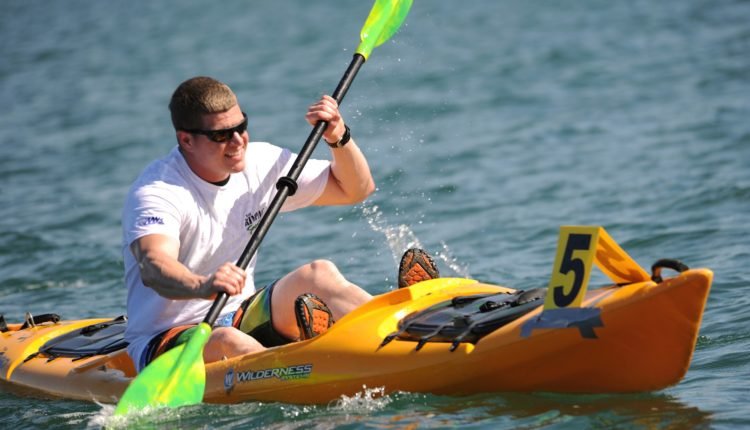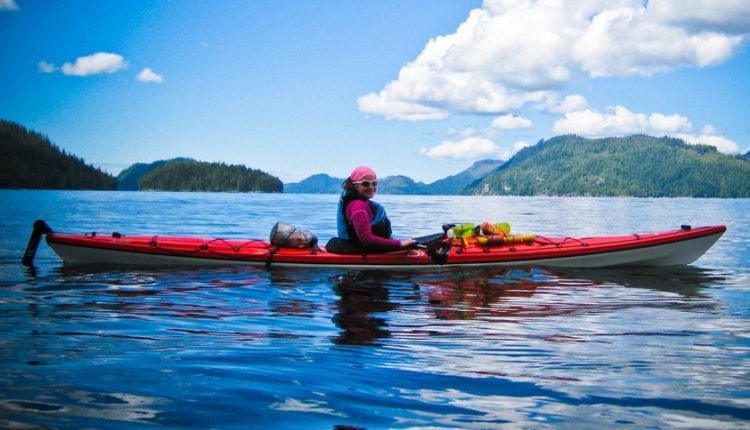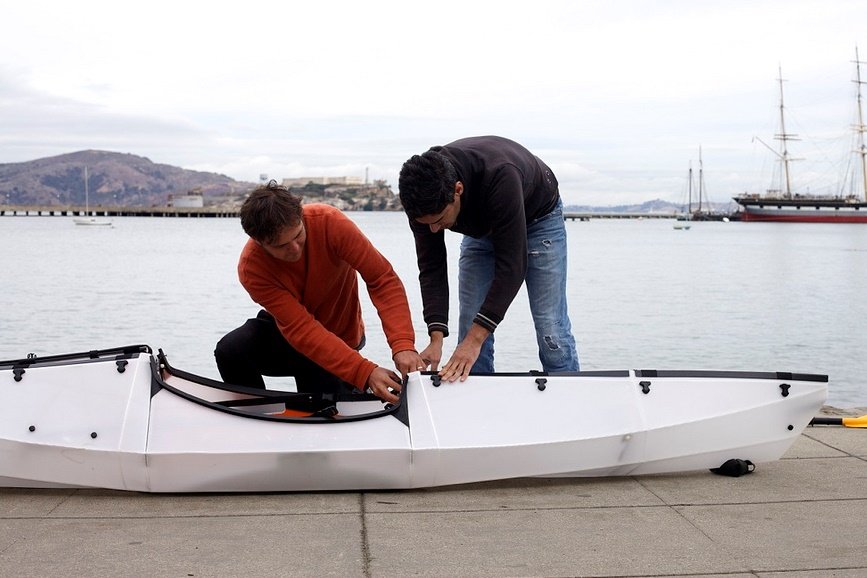What Types of Kayaks Are There? A Beginner’s Guide Explained
So, you want to buy a kayak.
Your friends all have them. They look like a lot of fun. Only problem is, you have no idea where to begin. What types of kayaks are out there, anyway?
Fortunately, your options are almost limitless. Kayaks — unlike most forms of transportation — have been around literally for thousands of years, meaning we’ve had some time to perfect things.
Of course, the Inuits who devised the first kayak were primarily concerned with survival; our guess is you probably just want something to splash around with next weekend.
What factors should I consider?
Generally, kayaks fall into three categories: those designed for speed, those designed for maneuverability and those designed for specialized features such as fishing, surfing or portability.
If you’re just getting your feet wet (no pun intended) a recreational or sit-on-top kayak can provide exceptional maneuverability and ease-of-use at a decent price, while a touring or sea kayak might be better for a seasoned paddler looking for a reliable boat to take on extended trips. Looking for something lightweight and portable? Inflatable kayaks could fit the bill.
Apart from price, the most important question is how you plan to use it. Let’s take a look.
The types of kayaks we’ll cover
In this guide, we’ll cover the following types of kayaks:
- Recreational kayaks
- Sit-on-top kayaks
- Fishing kayaks
- Touring and Sea kayaks
- Day Touring kayaks
- Tandem kayaks
- Whitewater kayaks
- Inflatable kayaks
- Kids kayaks
- Folding and Modular kayaks
Recreational (Sit In) Kayaks
- Shorter, wider for excellent stability
- Great for beginners, experts and casual paddlers alike
- Versatile uses for fishing, photography or day trips
- Affordable cost
For families and beginners just looking to get out on the water, a recreational kayak provides stability, comfort and user-friendliness at a reasonable price point. Best for relaxing days on a calm lake or pond, these versatile kayaks are meant for the casual paddler not particularly concerned with speed or high performance in open water or strong currents.
Check out American Paddler’s 10 best recreational kayaks
Recreational kayaks are generally shorter — 10 to 12 feet — and wider, providing a large cockpit and ample leg room for comfortable entry and exit. Because recreational kayaks are built for maneuverability, not speed, they are generally easier to turn, but don’t track as well as longer types of kayaks, such as touring or sea kayaks. However, recreational kayaks can be equipped with hand-operated rudders to help maintain a straighter course.
Recreational kayaks generally feature dry storage compartments in either the bow, stern or both, and can come in both single- and tandem (2-person) models.
Made of durable plastic, they are usually heavier to lift and transport.
Sit on Top Kayaks
- Easy to use, paddle and get on board
- Difficult to roll, impossible to sink
- Comfortable and versatile for fishing, swimming or paddling with a dog
- Recommended for warmer weather
Similar to recreational kayaks, sit-on-top kayaks are designed for those looking for stability and ease of use at a good price point. As the name implies, paddlers sit “on top” of the kayak’s deck, rather than in an enclosed cockpit, making it easy to board and dismount.
For those worried about capsizing, sit-on-top kayaks are actually among the safest kayaks out there. Despite the higher center of gravity, these types of kayaks are designed to be wider and more balanced — almost a hybrid between a kayak and a stand-up paddleboard — and it’s designed not to sink even if you do somehow manage to flip it. Because paddlers are not enclosed inside the cockpit, there is no risk of being trapped underneath in the event of a rollover.
American Paddler’s advice: Check out the Perception Tribe 9.5,
a great sit-on-top kayak for beginners.
With seats depression-molded into the top of the kayak, paddlers with larger body types or longer legs often find sit-on-tops a more comfortable experience. With a large deck area — typically 10-15 feet in length — and cargo space, sit-on-tops can be a great kayak for fishing, diving or even paddling with a dog.
Made from durable plastic, sit-on-top kayaks can come in single or tandem models.
Because paddlers are exposed to the elements, however, they aren’t recommended for colder weather.
Fishing Kayaks
- Wide, stable frames powered by foot pedals or small motors
- Ample storage for tackle, gear and rods
- Maneuverable for greater access to fishing locations
- Designed with comfort and durability in mind
Out with the motorboat, in with the kayak. Turns out anglers are rediscovering something the natives knew centuries ago: to snag the best fish, you’ve gotta get close.
Kayak fishing is a budding phenomenon among today’s anglers looking for a cheaper, quieter and more versatile option than traditional boats or canoes. Today’s fishing kayaks are built with the ultimate stability in mind, but also come equipped with everything an avid fisherman needs, from rod holders and tackle storage to wide wells for all types of gear.
For our recommendations, check out the Vibe Skipjack 90, the Old Town Predator MX or the Feelfree Lure 11.5 fishing kayaks
While some anglers might fret over the possibility of rolling a kayak during a battle of wills with a finned friend, these types of kayaks are designed to be rock-solid, with wide decks perfect for maneuvering and even doing a little stand-up fishing. High-back seats and upgrades can further enhance an angler’s comfort.
Underneath the boat, many fishing kayaks these days are equipped with pedal-controller propellers and rudders, or even small motors, meaning on a fishing kayak, it’s NPR: No Paddle Required.
Touring and Sea Kayaks
- Longer, narrower kayak, better for tracking and speed
- Perfect for long-distance trips in open water
- Large storage areas
- Durable, but more expensive
For paddlers looking for a little more oomph, a touring kayak — also known as a sea or ocean kayak — is built for speed, great tracking and better performance. Although a bit pricier, touring kayaks are ideal for those setting out on a daylong or multi-day excursion.
Trading maneuverability for speed, sea kayaks are longer and narrower than their recreational counterparts, typically around 16 to 19 feet. With a flatter hull designed to keep more of the kayak gliding through the water, touring kayaks are designed to make paddling more efficient, with a skeg or foot-controlled rudder to keep the kayak tracking straight and true.
In addition to greater stability, the added length allows more storage space for gear, perfect for the enthusiast who might need safety, survival or camping equipment on board. Touring kayaks often come with one or several internal bulkheads, which create airtight internal compartments for waterproof cargo space as well as flotation in the event of a capsize.
While touring or sea kayaks are built with durable, lightweight materials to withstand rougher conditions out in open water, they can also be used for recreational purposes. Like other types of kayaks, they can be single or double.
Day Touring Kayaks
- Good middle option between touring and recreational kayaks
- Comfortable and versatile
- Can handle longer trips, with ample storage space
- Great for intermediate-level kayakers
For paddlers who want a bit of everything, day touring kayaks split the difference between a traditional touring kayak and a recreational model. Day touring kayaks are shorter than a sea kayak — usually 13 to 14 feet — but longer than a recreational kayak, offering a good middle ground for speed, tracking, maneuverability and storage space.
Called “day touring” for a reason, they are designed for kayakers not necessarily looking for a weeklong kayak backpacking trip, but still interested in a longer day trip. Because they are shorter, day touring kayaks are more stable and can be more easily maneuvered for tighter turns, making it a nice option for the intermediate-level kayaker looking for a new challenge.
Day touring kayaks aren’t necessarily built for open-ocean kayaking, but they can easily handle coastline and inland waterways, and do a little better in choppier waters than recreational or sit-on-top kayaks.
Most models come with the same perks as sea kayaks, just … less of it. And usually at a lesser price.
Tandem Kayaks
- Paddle with a friend (or a dog)
- Two, three and four passenger models
- Recreational, touring or inflatable
- Carry more gear
While just about any type of kayak can be a “tandem” kayak, the best tandem kayak is the one that gets you out on the water. Tandem — or two-person — kayaks can come in any of the forms above, with many of the same considerations.
While inflatable kayaks are a popular choice for paddling in pairs, touring and recreational models also offer dual-cockpit options with ample space for two people. Some types, such as modular kayaks, can even add and take apart cockpit sections to switch between a single and a tandem kayak.
In fact, some kayaks aren’t limited to just two people. Three-passenger models — and in rare cases, four — also exist on the market for especially ambitious parties.
And, of course, who says a tandem kayak has to fit two “people,” anyway? Some models, such as sit-on-top types of kayaks, are well-designed to accommodate your canine friend, too.

Whitewater Kayaks
- Larger “rocker” for maximum maneuverability
- Shorter, wider frame
- Greater buoyancy to “pop” out of rapids
- Designed for use on high-current rivers, not calm waters
In a class of their own, whitewater kayaks are designed for maximum maneuverability, because, let’s face it: you’re going to need it.
Rushing down those rapids headlong into a pile of boulders, you’re not necessarily concerned with speed. You’ve got plenty of it already.
With a length half that of a touring kayak and a little wider, the whole focus of a whitewater kayak is to allow the paddler to have as much control as possible for easy turns and quick reactions. It does this through the use of bigger “rocker” — a term referring to how much of the bow and stern are above the water, similar to the bottom of a rocking chair. While a touring kayak has an almost flat bottom, the ends of a whitewater kayak are completely out of the water, allowing the paddler to turn on a dime.
The flip side is that a whitewater kayak isn’t built for speed or efficiency, and is almost impossible to paddle in a straight line. As such, it isn’t meant to be used on calm bodies of water or for touring.
Whitewater kayaks are also known for having greater buoyancy, allowing the kayak to “bounce” out of rapids or waterfalls.
Inflatable kayaks
- Lightwight, easy to store and transport
- Available in recreational, sit-on-top and touring designs
- Durable, puncture-resistant materials
- Less expensive
I know what you’re thinking: Inflatable kayaks? Aren’t those for kids’ pool parties?
The truth is, inflatable kayaks have come a long way in a short time, and today’s models are a far cry from the uncomfortable, cheap and puncture-prone blow-up toys of yesteryear.
Check out American Paddler’s 7 best inflatable kayaks of 2018
With strong and durable materials and many different variations and designs, today’s inflatable kayaks are seaworthy vessels that can earn the respect of even the most seasoned paddler. Usually made of PVC or a strong hypalon exterior, they’re built to withstand the beating waves better than you might imagine. Some even come with lightweight aluminum frames to help the kayak keep its shape for better speed and tracking.
Of course, even the best inflatable kayak isn’t going to stack up to a non-inflatable boat, but the advantages of lighter weight, easier storage and lower cost than other types of kayaks make inflatables a viable option for just about any kind of paddling.
Most inflatable kayaks clock in under 14 feet — an appropriate length to maintain stability on the water — and some come equipped with skegs to help with tracking.
Kids Kayaks
- Lightweight, shorter models designed for shorter people
- Touring, recreational or inflatable styles
- Stable enough for a beginner
- Comfort, experience factors in choosing kayak
While it’s generally inadvisable for children under 7 to paddle their own kayak, for older children — with appropriate supervision — kayaking can be a rewarding and fun outdoor family activity.
Check out American Paddler’s 9 best kayaks for kids and teenagers.
Generally, kids kayaks mirror their grow-up counterparts in style, with size and weight being the biggest difference. When choosing a kayak for your child, take stock of the youngster’s paddling style and choose a boat that will be both comfortable and safe. While a wider kayak might provide more stability for a timid beginner, it can also make paddling a little more difficult for those shorter arms. Finding a balance is key.
Kids kayaks come in open-top, enclosed cockpit or even inflatable designs, with different types of kayaks recommended based on the young paddler’s weight, experience and needs. Often, kids kayaks come with a tow hook setup, so when those little arms do give out, hitching up to mom or dad is a snap.
Folding and Modular Kayaks
- Collapsible for easy storage and transport
- Comparable performance to hard-shell models
- Modular kayaks are customizable
- Ample on-board storage
For those looking for easier storage and transport, but not quite ready to go the inflatable route, a folding or modular kayak might be the way to go.
Modular kayaks — which snap apart into hard-shell sections — and folding kayaks — which feature a strong, rigid framework covered by a durable exterior skin — are built with the same general concept in mind, but offer slightly different features.
While both have the advantage of being collapsible for quick and easy storage, folding kayaks are generally longer and lighter weight, designed with the touring performance of a sea kayak in mind. A folding kayak can collapse down to the size of a backpack, and usually takes 15-20 minutes to assemble.
Modular kayaks, on the other hand, are made of the same durable materials as a hard-shell kayak but snap apart into sections that can easily fit into the back of an SUV. While obviously a bit heavier than their folding counterparts, modular kayaks offer all the same benefits of traditional hard-shell types of kayaks and can come in recreational, touring or sit-on-top styles. They’re also customizable. Want to make your modular a tandem? Buy another section!
Both models offer ample on-board storage space.











